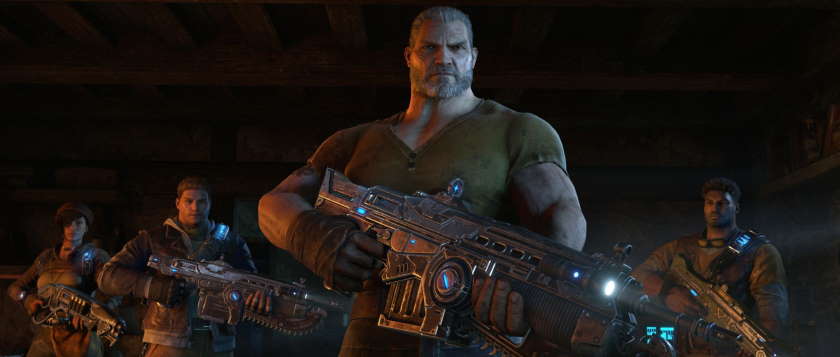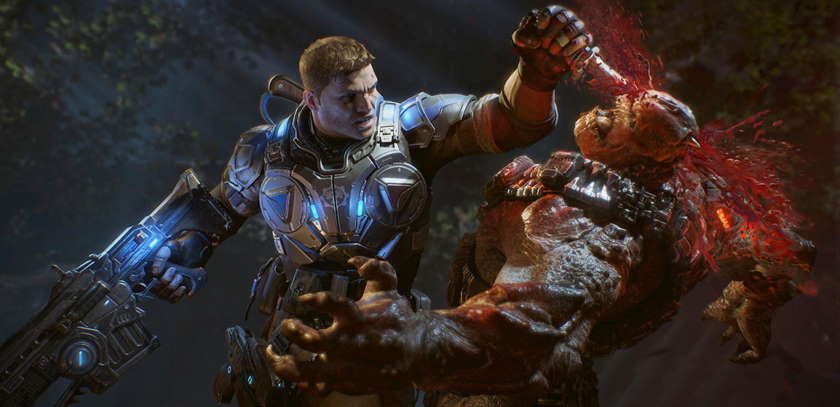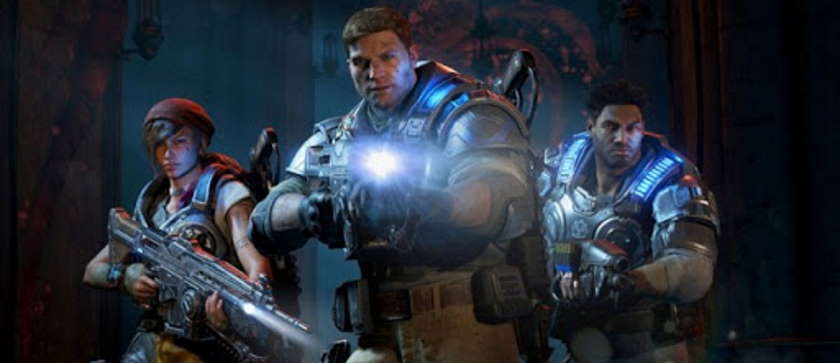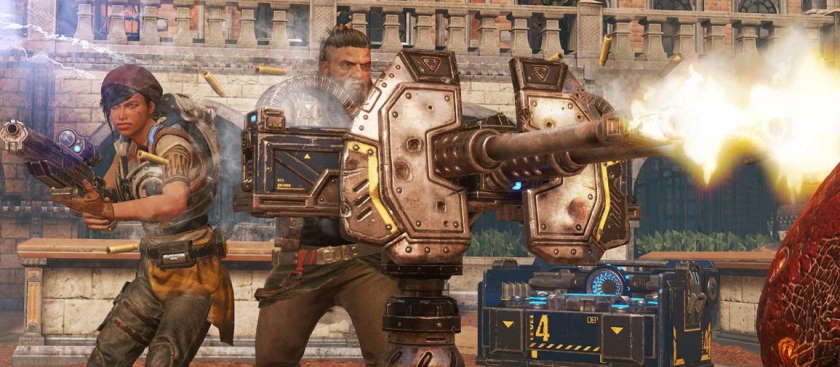Gears of War 4

Rod Fergusson is clearly a man with a deep love for the Gears of War franchise. He quit his job as a producer with Microsoft Game Studios in order to join Epic Games and save the first entry of the franchise from a Hellish development. He had left to join Irrational Games to help ship Bioshock Infinite once Epic decided the third game would be their last. When Microsoft had purchased the rights to Gears of War, Fergusson rushed back in order to continue working on a franchise he loved.
Rebranding Black Tusk studios into Gears of War factory The Coalition meant entrusting the franchise to a team that had largely never worked on the franchise before. With this in mind, Fergusson had tasked the team with recreating individual combat arenas and set pieces from the first three games. He wanted the team to understand the franchise mechanics intimately: how the timing of waves and distance from an opponent could influence the feel of a skirmish. It was crucial for Ron that the team know what it meant to be a Gears of War game.
I believe this dedication is the sole reason Gears of War 4 was as competent as it was. The fundamentals of the franchise remain intact. However, I can’t help but feel as if I’d rather be fighting the Lambent again, a feeling I never expected to have.
It may be more fair to compare Gears of War 4 with the original Gears of War directly. Each game represents a development studio’s first foray into this unique franchise, kicking off a whole new story of subterranean invasion. It is perhaps the structure of the campaign that bears the most similarity, the feeling of a single, simple mission in the scope of a greater war. Our characters only visit a handful of locations, one after the next, their objective clear and simple from start to finish. Rather than telling a grand epic, the narrative is used to build and give a glimpse into a whole new world.
How unfortunate that the strongest element of Gears of War 4 still manages to fall short in comparison. While the games are structured similarly, the characters and narrative fail to provide the title the same support that Gears of War enjoyed in spite of and because of its simplicity. While you could summarize the concept of the first game as an alien invasion from underground rather than the stars, the atmosphere of the game was made all the stronger due to uncommon sources of inspiration. Despite being a science-fiction shooter featuring space marines, Gears of War looked nothing like its competitors or contemporaries. The ruined gothic architecture drew to mind images of war torn Europe in World War II rather than the explosive set pieces of futuristic Star Wars or Star Trek.

“Well if you’d just sit still it would have been out of your eye by now!”
The very first levels of Gears of War 4 lose this gothic “destroyed beauty” aesthetic. The flashback to the old Pendulum Wars has the players rushing in towards a high tech facility that lacks the rust and grit of the top secret laboratory of Gears of War 2. Our story begins with the heroes breaking inside of a sleek, ultramodern city whose aesthetic is populated almost exclusively by machinery. The robotic aesthetic resembles modern construction and warehouse equipment rather than something more old-fashioned, gritty, and rusted over. Instead of looking uniquely Gears of War, the opening chapters resemble any generic current generation sci-fi shooter hoping to impress with pretty graphics, particle effects, and fancy texture-mapping. The wholly unique atmosphere of the prior games is gone.
The protagonists themselves are much the same. Though the original trilogy was criticized for presenting “hyper-masculine space marines”, each of its heroes was distinct from one another. Baird was far less burly than his companions, defined instead by a sarcastic and sardonic wit as well as intelligence. Cole was the idealized football star with a whole lot of energy coupled with enough humility to join the military. It would not surprise me if the production bible at Epic studios included “Loves his mama” as a bulleted item in his profile. Marcus himself is a jaded soldier, dedicated to completing the mission but only by necessity of survival rather than loyalty to the COG.
Only Dom presents a bit of trouble to define, characterized almost exclusively by his mission to find his wife. Despite attempts at giving him a series of emotional outbursts throughout the trilogy, his quips and comments offer little personality for the audience to truly latch onto. Even so, that he at least has a personal goal gives him a greater sense of depth than any of our protagonists in Gears of War 4. Despite being three distinct individuals, JD, Del, and Kait all provide the same sort of snark commentary, attempting to exchange Whedonesque witticisms without the charm or charisma of any of the actors from Firefly, Buffy the Vampire Slayer, Angel, and so on. Only Marcus Fenix packs a punch of personality, and that has more to do with the excellence of John DiMaggio’s vocal embodiment of the gruff, retired soldier than any effort of the writers. In the later stages of the game Marcus suddenly begins to act the part of the tech-head, spouting off knowledge that would once have belonged to Baird. It was at that moment that the paper-flat character of our heroes became apparent: no one had even thought to add a Donatello to this gang of Ninja Turtles.
The setting and characters feel like an attempt to “correct” the over-abundant complaints of shallow social media addicts and game industry pundits, rebellious to any demonstration of what could be perceived as raw masculinity. It did not matter that the first two games frequently juxtaposed such bravado against the frightening horror that the Locust’s overwhelming odds represented; that no amount of muscle or strength could stop the psychological or emotional damage that these creatures inflicted. War is Hell, and if even the stone structures of civilization could be brought to rubble then what did that mean of the soft flesh of mankind?

Calling these three Larry, Curly, and Moe would do a disservice to the care spent developing the unique characteristics of each of the Three Stooges.
Not that Epic themselves presented these ideas with consistency or panache. The stories in these games have always been a mess, but Gears of War 4 feels all the more vapid and generic. Someone else’s vision hijacked by those that lack their own. The Locust are gone… sort of. They’re called the Swarm now, which is totally different. They still have Drones, but all the other interesting subspecies have been abandoned in favor of the Scion, a slow-moving bullet-sponge that, on paper, seems like a skinny replacement for the Boomer.
In fact, the Scion and “Juvies” – what the characters refer to the smaller, scrambling critters that replace the Wretches of prior games – demonstrate the subtle ways in which Gears of War 4 is the same Gears of War you remember, but… off. The Boomer itself was a slowly advancing creature, often carrying a heavy weapon of sorts and absorbing greater damage than the Drones could. Yet the characteristic, bass-voiced “Boom” they uttered before firing an explosive communicated the need to dive behind cover and avoid the rocket-propelled grenade about to soar their way.
The Scions lack such a clear, characteristic announcement of intent when they fire their weapons. The most powerful guns in the game take exorbitant quantities of ammunition to bring one down, more so than even the hulking Boomers required. It’s one thing to introduce a foe that has a tenacious constitution. It’s another to completely drain a player’s stores of ammunition on just one of many foes upon the battlefield, far more than it ought to require.
Let us now examine the discrepancies between cover in the original trilogy and in this fourth entry. Regardless of which of the original games you played, staying behind cover protected you from the majority of damage. Even the splash damage from explosions was less lethal, save for an explosive that struck the player directly or dropped at their feet.
This is largely due to the unrealistic nature in which the “Stop and Pop” gameplay was developed. It might help to think of it in terms of Mario and Rabbids: Kingdom Battle, where chance-to-hit operated on a simple percentage chance of 100%, 50%, or 0%. While this isn’t particularly accurate regarding Gears of War, it at least helps describe the amount of damage absorbed by cover from otherwise lethal splash damage. In regards to enemy fire, the Locust are likely programmed to target a specific point on the player character, ensuring they hit whatever crumbling pillar or barrier the player has ducked behind. Only when the Locust are in a properly elevated or flanking position will their shot hit.
Keep in mind this is my current guesswork based on the differences between the games, particularly on the Hardcore mode of difficulty. Being out of cover at any time was particularly lethal, with only enough time to roadie run on over to a shattered wall or pillar. Once you had your head ducked down, however, damage dramatically decreased and offered a reprieve. It developed a pace to the gameplay, where you’d poke your head up to fire against the enemy before quickly ducking back down, perhaps reloading your weapon as the Crimson Omen faded back out and indicated a return to full health. Context-sensitive prompts to swap cover included invincibility for a brief time. Everything about the game feels engineered to keep the player plastered to cover for safety.

You think that’s gonna stop ‘em? You’d do more damage throwing rusty thumb tacks in their faces. They might at least get tetanus that way.
Gears of War 4 seems to have abandoned any unseen, background calculation that made cover so ideal. Enemies positioned at 11 o’ clock at the same elevation as the player may still land their shot. This makes good positioning a far more difficult idea to determine, and often the further you were from the enemy the more safe you were. This results in a number of the mid- or close-range weapons being far less useful as long-range options become your best bet.
Speaking of unseen calculations, even weapons such as the shotgun feel far less powerful. What used to be a close-ranged necessity now seems to have been handicapped even for the campaign. Any of the game’s turrets similarly feel inadequate compared to the troika guns of the prior trilogy.
I want to give credit to Rod Fergusson, as he loved and understood the franchise enough that he led a team into making a most convincing imitation of Epic’s trilogy. Characters certainly move like they used to, and regardless of the botched aesthetic the game looks and sounds like you’d expect a Gears of War to look. The botched effectiveness of both cover and the multitude of weapons instead reveals Gears of War 4 for the Xerox copy it actually is. Sometimes it really is the little details that are most important, and in this case it has developed a weaker experience that I’d rather not return to.
There is only one thing I can compliment the game on, and that is the increased use of environmental hazards. While there are your generic explosives scattered about the different levels, there are also whole hunks of construction equipment held aloft by fragile cables and hooks. A few shots and you can crush a number of foes beneath the heavy metal brought forcefully down by gravity. There are similar hazards to aim for during turbulent storms, scattering the sharp or hefty materials across the battlefield and into the enemy’s positions.
Such a minor addition hardly saves the game, though. It’s merely an idea that I wish had been implemented into the prior, better games.
Perhaps Gears of War 5 will fix some of these issues.


